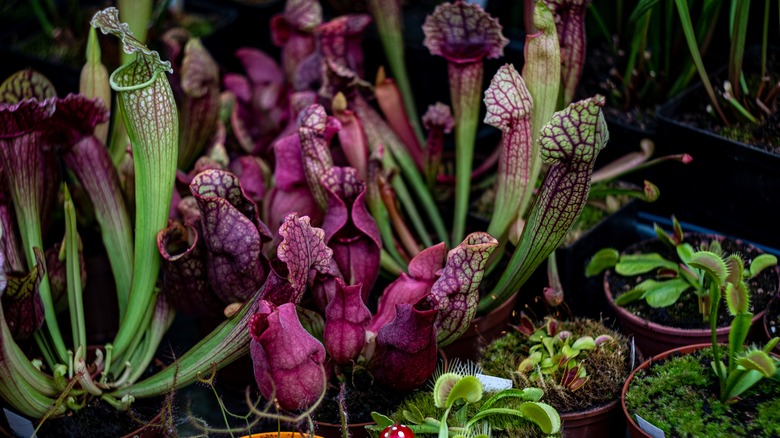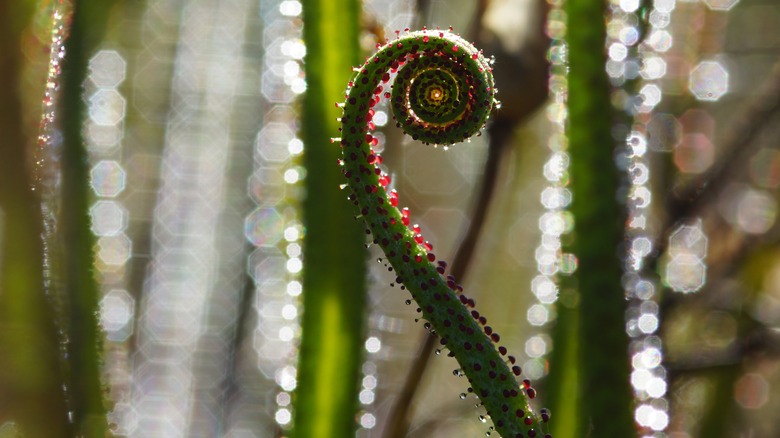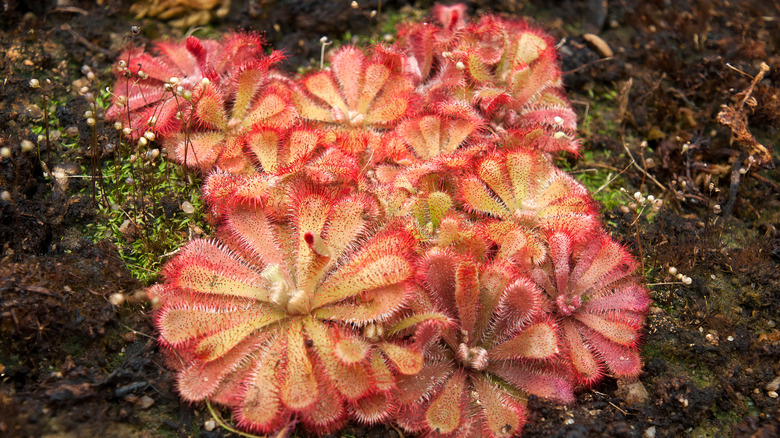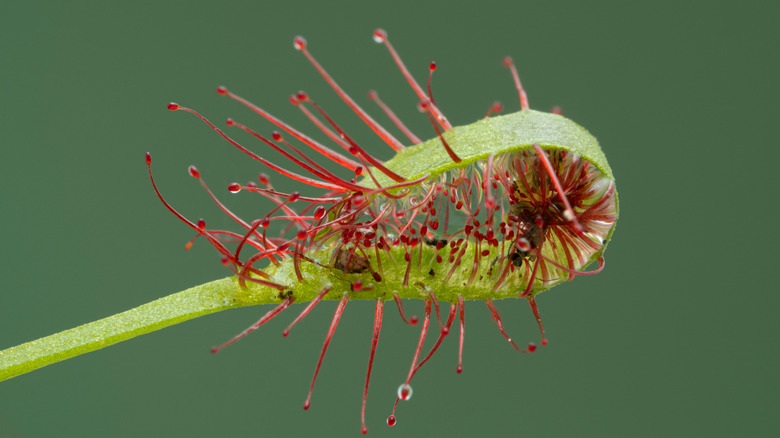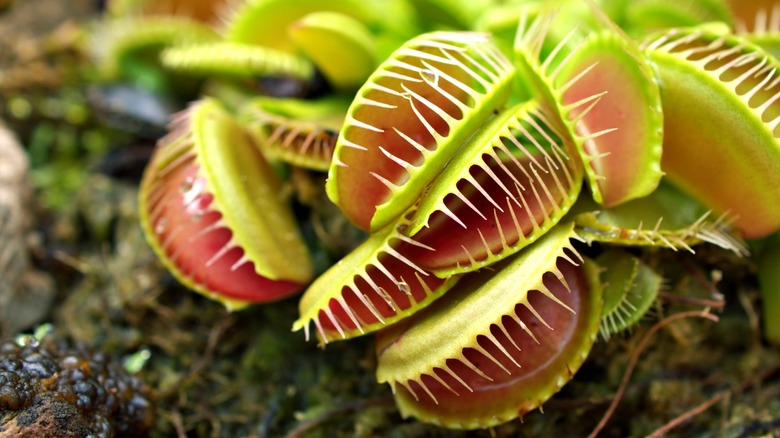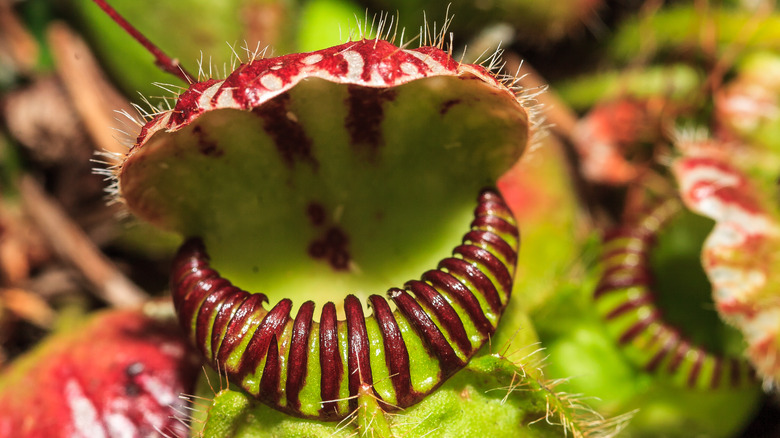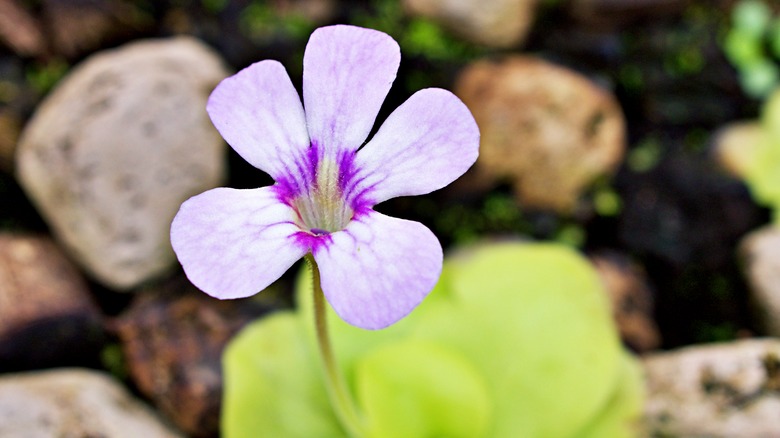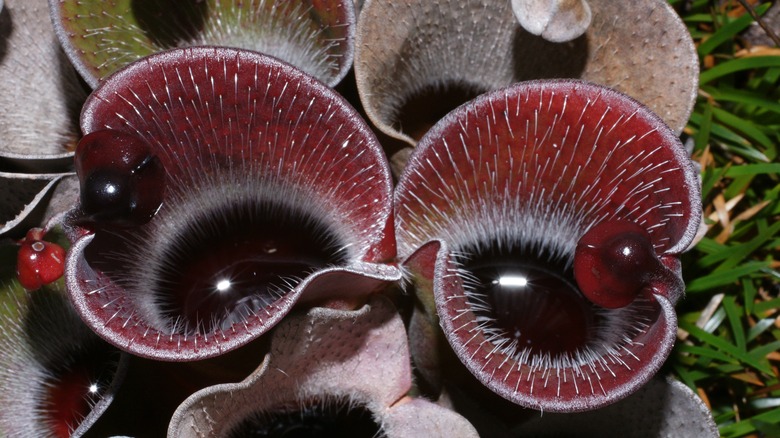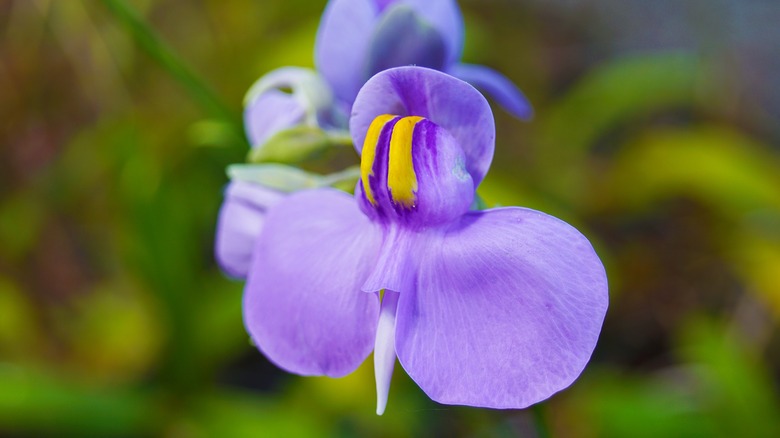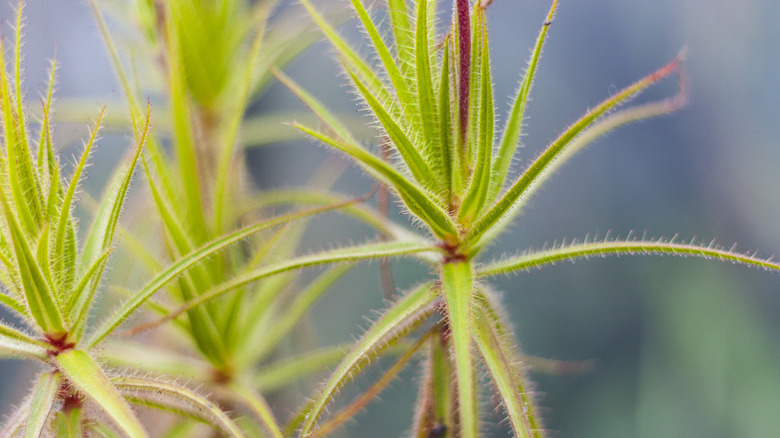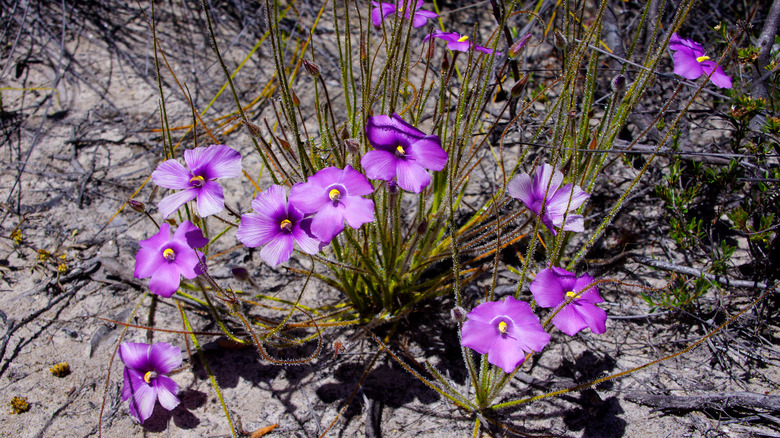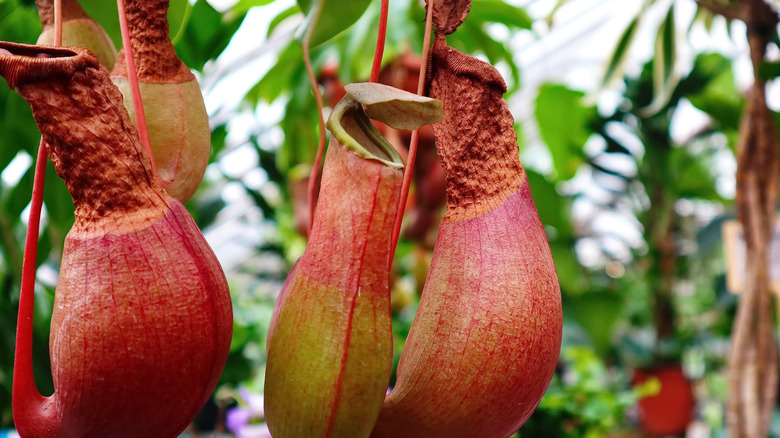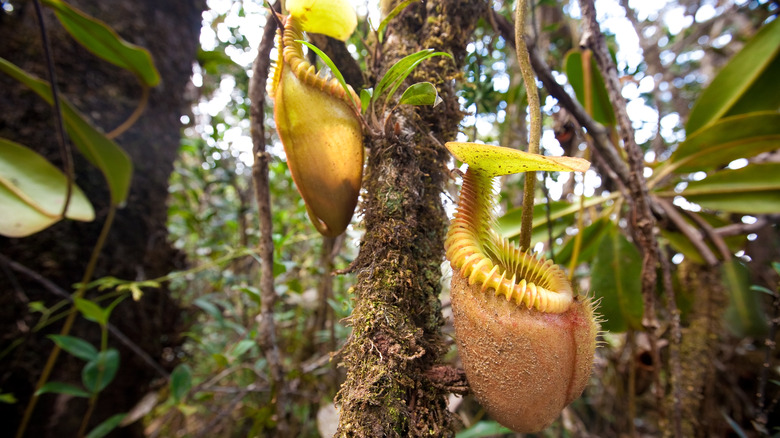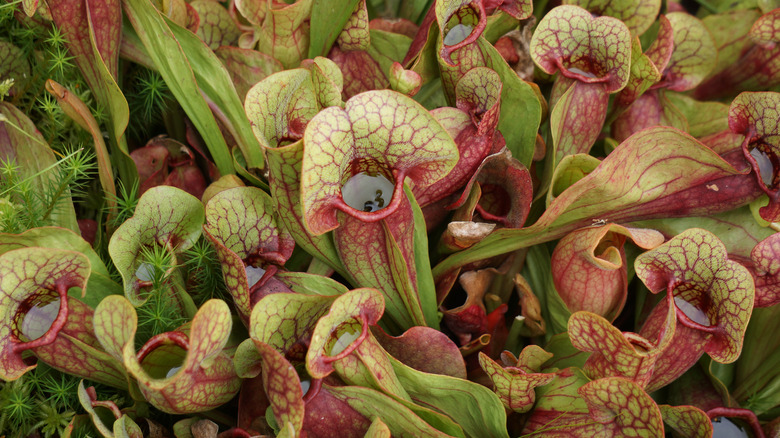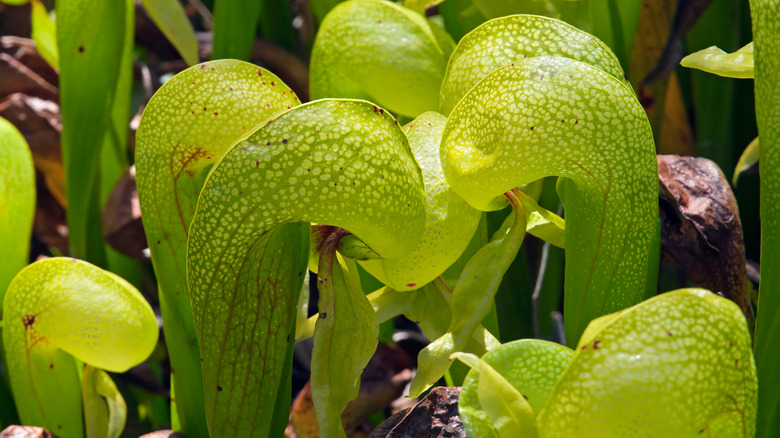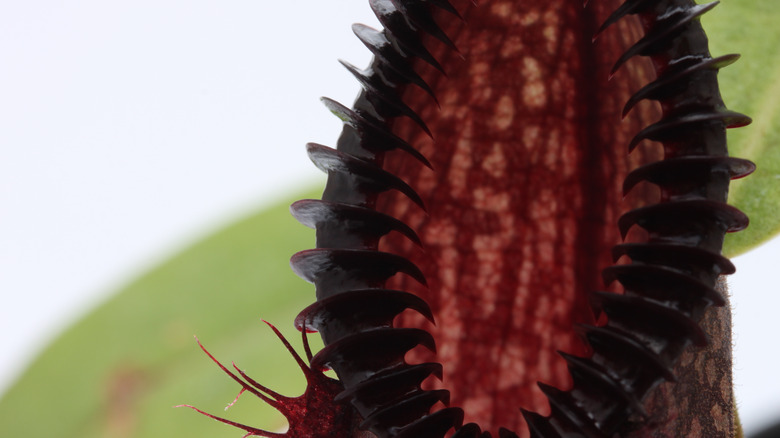15 Carnivorous Plants That Thrive In Warm Climates
We've all heard of the insect-eating Venus flytrap, but did you know there are plants that consume entire animals? It's safe to say that though they are cool, they're also creepy. Carnivorous plants are not for the faint of heart. Butterworts, Bladderworts, Heliamphoras, monkey cups — they also have really weird names.
The International Carnivorous Plant Society says there are three factors that make a plant a flesh-eater. First, it must not only capture prey but also kill it. Second, it needs to have a biological system in place to digest its victim. Finally, the plant must receive nutritional value from its meal. No hunting for sport here. This is how carnivorous plants survive.
Naturally, these are the cooky monsters we expect to find lurking in the depths of undiscovered tropical forests, and there's good reason for that. One thing most carnivorous plants have in common is they like warm climates with high humidity. Some have traps that close around an unsuspecting guest. Some have pitcher-shaped bulbs that insects unwittingly fall into after they're lured there by sweet-smelling nectar. And some have even evolved to trap their prey underground. Yikes.
If you're curious about these unusual plants, we don't blame you — because so are we. Before getting started with your own carnivorous garden of flesh-eating flora, read on for some helpful information on 15 species that will thrive in warm climates.
1. Dewy pine
There's only one Dewy Pine (Drosophyllum lusitanicum) and it holds court on its own just fine. The dew referred to in its name is actually glue that glistens in the sunlight. This plant emits a honey-like scent to attract insects, who then get stuck to the leaves. Digestive enzymes dissolve their tissue into a liquid, which is absorbed by the plant.
Bloom Season: Yellow flowers in spring
USDA Hardiness Zones: 9 to 11
Growing Conditions: Hot sun, can easily withstand heat over 100 degrees Fahrenheit, not suitable for indoor growth
Soil Type: Dry, sandy
Size: Sprawling bush
2. Princess Alice's sundew
Drosera aliciae, or Princess Alice's sundew, is widely considered one of the easiest carnivorous plants to grow and care for. Similar to the Dewey Pine, it also has sticky hairs along its leaves that catch and digest insects, per the Royal Horticultural Society. It is native to South Africa and it happily tolerates poorly drained soil.
Bloom Season: Pink flowers in summer
Growing Conditions: Full sun, humidity over 60%
Soil Type: Consistently moist, peat moss mixed with sand
Size: Up to 4 inches tall and 20 inches wide
3. Cape sundew
Another great starter option is Drosera capensis, the Cape sundew, so named for its origination on the cape of South Africa where it grows so profusely that it's considered a weed. Grow Sundews lists quite a few varieties of Drosera capensis, including plants with wide or narrow leaves, a red cultivar, and an albino.
Bloom Season: Pink flowers in spring and summer
USDA Hardiness Zones: 7 to 9
Growing Conditions: Full sun, wet
Soil Type: Moist, tolerant of a range of soil types
Size: Up to 5 inches wide in a container, much larger when planted outdoors
4. Venus flytrap
Most of us recognize the Venus flytrap (Dionaea muscipula). Missouri Botanical Garden recommends a bog garden to maintain consistent moisture for these guys. Venus flytraps use nectar to lure prey. Insects inevitably, though unwittingly, cause the trap to clamp shut when they touch one of three trigger hairs. There they remain until they die and are slowly consumed over the course of a week.
Bloom Season: White flowers in spring
USDA Hardiness Zones: 7 to 10
Growing Conditions: Sun and high humidity
Soil Type: Consistently moist, peat moss mixed with sand
Size: Up to 12 inches tall
5. Cephalotus
Is it just us or does this one look like it's smiling and saying hello? Don't be fooled. According to Curious Plant, Cephalotus follicularis is an Australian pitcher plant with five different tactics for trapping prey: sweet nectar, slippery interior walls within the traps, and that toothy grin to name a few.
Bloom Season: Late summer
USDA Hardiness Zones: 9 and 10
Growing Conditions: Full sun to partial shade, does not tolerate constant moisture, prone to root rot
Soil Type: Well-draining, sand mixed with sphagnum
Size: Up to 8 inches tall
6. Butterworts
Don't be tricked by this cute little thing either. Butterworts make up the Pinguicula family of carnivorous plants. Pinguicula moranensis, shown above, may have a delicate purple flower for show, but it also has sticky leaves covered in mucilage that insects mistake for nectar. Once an insect sticks to the leaf, it rolls over and slowly swallows it whole.
Bloom Season: Various colors bloom in summer
USDA Hardiness Zones: 10 and 11
Growing Conditions: Sun to partial shade
Soil Type: Consistently moist; perlite, vermiculite, and sand
Size: Up to 10 inches tall
7. Heliamphora
With a view from above, looking down into the traps of the Heliamphora pulchella, you can see the nectar spoon that differentiates them from other carnivorous plants. This part of the leaf dangles over the trap and is filled with insect-attracting nectar. Heliamphoras are often called sun pitchers. They're originally from Venezuela, Guyana, and Brazil in South America.
Bloom Season: White or purple-pink flowers in winter and spring
USDA Hardiness Zones: 9 to 11
Growing Conditions: Full sun, high humidity
Soil Type: Nutrient deficient yet moist; perlite, sand, and peat moss
Size: Up to 20 inches tall
8. Bladderwort
Bladderworts love swamp-like environmental conditions where they feed on water flies and mosquito larvae, as explained by the NC State Extension Gardener Plant Toolbox. Utricularia reniformis, pictured above, produces delicate blue-ish purple flowers and traps called bladders. These truly unusual plants can be found securely anchored but they can also float freely in water.
Bloom Season: Pink, purple, white, or yellow blooms in spring and summer
USDA Hardiness Zones: 5 to 11
Growing Conditions: Full sun
Soil Type: Acidic; standing water is tolerated
Size: 1-inch flowers on stems up to 5 inches tall
9. Roridula
Roridula gorgonias is aptly nicknamed the flycatcher bush. It's a little bit different than the others in that it does not emit digestive enzymes to liquify and absorb its victims. Instead, according to Sarracenia Northwest, it catches insects on its sticky leaves, which are then eaten by assassin bugs that live inside the plant. Fast forward a bit. The bugs poop and, in turn, the plant receives nutrients.
Bloom Season: Summer and fall
USDA Hardiness Zones: 8 and 9
Growing Conditions: Full sun
Soil Type: Consistently moist, sand mixed with peat moss
Size: Up to 6 feet tall
10. Australian rainbow plants
Byblis gigantea, shown above with purple flowers, in native to Australia. Its common name is the rainbow plant because its flowers have been identified in all seven colors of the rainbow. Carnivorous Plant Resource says these plants catch and consume insects on their own, but they are also believed to have a similar symbiotic relationship to assassin bugs like the roridulas.
Bloom Season: Summer
USDA Hardiness Zones: 8 to 10
Growing Conditions: Full sun
Soil Type: Consistently moist, sand mixed with peat moss
Size: Up to 12 inches tall
11. Nepenthes alata
Now we enter Nepenthes territory. These are the carnivorous plants known to eat rodents. As explained by Smithsonian Magazine, Nepenthes will consume anything that falls into their pitcher traps. Pictured above, the Nepenthes alata is the standard tropical variety of this plant with lime green leaves and large red pitchers.
Bloom Season: Intermittent
USDA Hardiness Zones: 10a and 10b
Growing Conditions: Full sun to partial shade
Soil Type: Consistently moist, sand mixed with sphagnum
Size: Plant can grow up to 3 feet tall with individual pitchers up to 7 inches long
12. Monkey cups pitcher plant
Nepenthes villosa is another form of pitcher plant. It is rare and difficult to grow because it requires very specific growing conditions that mimic its natural habitat. According to Fierce Flora, this variety is only found at very high elevations in tropical regions.
Bloom Season: Blossoms may form but it is a very rare occurrence
USDA Hardiness Zones: 10a and 10b
Growing Conditions: Full sun to partial shade
Soil Type: Well-draining, sand mixed with sphagnum
Size: Individual pitchers can be up to 10 inches long
13. Purple pitcher plant
The purple pitcher plant (Sarracenia purpurea) is sometimes also called the saddle flower, per the U.S. Forest Service. Sort of like those strips of spikes that can only be driven over in one direction, this plant has sharp, pointed hairs within its traps that stop insects from backing up and escaping once they've entered the pitcher.
Bloom Season: A single dark red flower in mid-spring
USDA Hardiness Zones: 3 to 9
Growing Conditions: Full to partial sun
Soil Type: Well-draining, peat moss mixed with sand
Size: 10 to 12 inches tall
14. Cobra lily
Darlingtonia californica, the cobra lily, stands out from the crowd in height (up to 3 feet) and yellow-green hooded leaves. This plant is so special that it has an entire state park dedicated to its preservation. Darlingtonia State Natural Site in Near Florence, Oregon gives visitors a front-row seat to the carnivorous action via a boardwalk that meanders through 18 acres of boggy swamp land.
Bloom Season: Purple flowers in spring and summer
USDA Hardiness Zones: 8
Growing Conditions: Full sun
Soil Type: Consistently moist, boggy
Size: Up to 3 feet tall
15. Nepenthes hamata and Nepenthes pudica
Nepenthes hamata has the scariest teeth of them all. Pictured above, this deep maroon pitcher plant doesn't hold back when it comes to creepiness. A close cousin is Nepenthes pudica, the newest plant to earn a ranking among the most lethal to insects and rodents. The pudica variety recently discovered in Borneo has been shown to grow pitcher plants in dark underground cavities where it traps and extinguishes prey before it sees the light of day.
Bloom Season: Unknown
USDA Hardiness Zones: 8 to 10
Growing Conditions: Full sun
Soil Type: Consistently moist
Size: 10 to 12 inches tall
